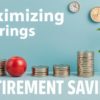
I was lucky enough to be able to see my entire family recently to celebrate my mom’s 70th birthday.
This was the first time we have all been together in almost two years, so we had a lot of catching up to do.
Of the six adults other than myself at the gathering, five of them asked me to take a look at a body part (or two) that had been bothering them for some time. It ended up being two knees, two hips, a low back, an elbow and a stubborn shoulder.
Later in the evening, we got to talking about retirement savings plans (I know, we’re a wild bunch). My parents shared their experience as the only actual retirees in attendance. My brother-in-law, who works in finance, went over some of his strategies, and the rest of us bounced around ideas that we had tried or heard of.







